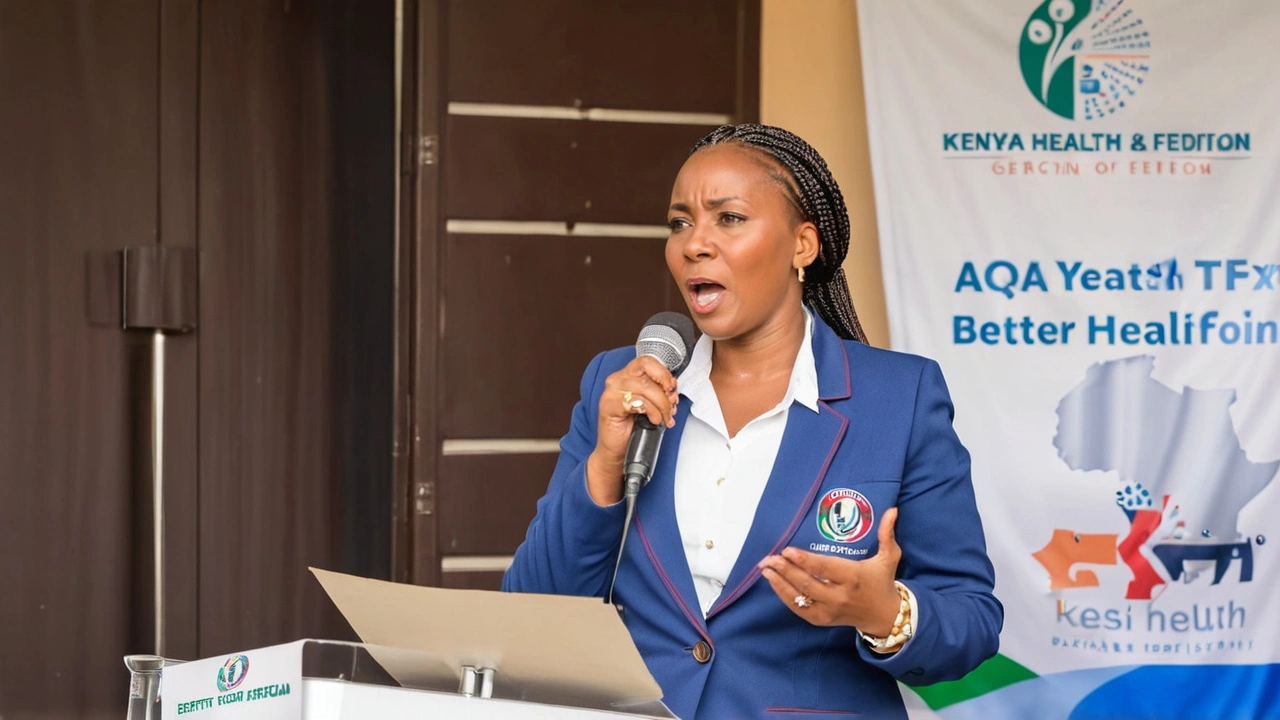Health Ministry Issues Critical Alert Following Sodium Cyanide Spill in Kiambu
The Kenyan Ministry of Health has raised a red flag after a serious incident in Kiambu County where a truck transporting sodium cyanide overturned, leading to a dangerous spill. This incident took place in the Kambembe area of Rironi, posing an immediate risk to public health and the environment. Public Health Principal Secretary Mary Muthoni has urgently advised residents to keep clear of the accident site and to fully cooperate with response teams working to manage the situation.
The Incident
The accident happened when the truck transporting sodium cyanide, a highly toxic substance, lost control and overturned. The spill quickly spread, leading to widespread concern among local authorities and residents. The chemical, used in mining and industrial processes, is known for its potent toxic effects, even in minuscule quantities. The rapid response from the Ministry of Health highlights the gravity of the situation.
Immediate Steps Taken
Emergency and disaster response teams were dispatched right away to contain the spill. The area has been cordoned off to prevent people from coming into contact with the hazardous substance. Specialized hazardous materials (HAZMAT) teams are working around the clock to neutralize the sodium cyanide and prevent it from contaminating the surrounding environment, including nearby water sources. Authorities are also monitoring air quality and water safety to ensure that there is no broader impact on public health.
Understanding Sodium Cyanide's Toxicity
Effects on Human Health
Sodium cyanide is a substance with extreme toxicity, and exposure can be deadly. Ingesting or inhaling even small amounts can result in severe symptoms such as headache, dizziness, shortness of breath, nausea, and vomiting. Individuals who experience prolonged or repeated exposure to this chemical may suffer from chronic health issues like neurological damage, thyroid dysfunction, and cardiovascular problems.
The urgent public alert stressed the need for anyone who might have been exposed to seek immediate medical attention. Hospitals in the surrounding areas have been prepared to handle potential cases of poisoning, and public health officials have urged residents who feel unwell to report their symptoms without delay. Schools and workplaces in the vicinity have been temporarily closed to ensure the safety of the community.
Environmental Impact
The threat posed by sodium cyanide extends beyond human health. When released into waterways, it can cause massive fish kills and long-term damage to aquatic ecosystems. The substance disrupts the oxygen carrying capacity of water, leading to suffocation of aquatic life forms. This not only upsets the ecological balance but also impacts local economies dependent on fisheries and tourism.
Protective Measures
In the wake of the accident, the Ministry of Health has outlined several protective measures for the public. Residents are urged to follow these guidelines:
- Avoid the vicinity of the spill site at all costs.
- Do not consume water from potentially affected sources until tests confirm safety.
- Pay attention to updates from health and environmental agencies.
- Report any unusual health symptoms to medical authorities immediately.
These steps are crucial to mitigate the impact of the spill and to protect the health and well-being of the community.

Ministry's Commitment to Public Safety
In her statement, Public Health Principal Secretary Mary Muthoni emphasized the Ministry's unwavering commitment to safeguarding public health. She reassured the public that all necessary steps are being taken to manage and contain the situation. The Ministry’s quick actions and clear communication highlight the importance of preparedness in responding to hazardous substance incidents.
Addressing Broader Risks
This incident serves as a stark reminder of the risks associated with transporting hazardous materials. The Ministry of Health and environmental agencies are likely to review existing protocols to prevent future occurrences. Stricter regulations and enhanced safety measures may be implemented to ensure that such accidents are minimized.
The public's cooperation during this critical time is essential. As response teams work to neutralize the sodium cyanide and prevent further harm, the community's support in following safety guidelines is vital. Together, these efforts aim to restore normalcy and secure the health and safety of everyone affected.
Conclusion
The sodium cyanide spill in Kiambu County is a grave event that has brought to light the severe risks posed by hazardous materials. The Ministry of Health's swift actions underscore the importance of preparedness and public awareness in managing such crises. As efforts continue to control and mitigate the spill, the health and safety of the community remain the top priority.
The incident is a call to action for improved safety measures in the transportation of hazardous substances. It also highlights the need for ongoing vigilance and collaboration between government agencies, response teams, and the public to ensure a safe and healthy environment for all.


pradeep kumar
July 21, 2024 AT 18:40A cyanide truck rollover is a textbook case of regulatory failure.
love monster
July 21, 2024 AT 18:45The emergency response team’s rapid deployment of HAZMAT units illustrates the application of incident command system (ICS) principles.
From a risk assessment standpoint, the spill area presents acute inhalation hazards due to cyanide’s volatility.
Air monitoring stations must be calibrated to detect hydrogen cyanide (HCN) at parts-per-billion levels to safeguard nearby residents.
Simultaneously, water quality labs should prioritize spectrophotometric analysis for cyanide concentrations in runoff streams.
The Ministry’s advisory to avoid water consumption aligns with the precautionary principle embedded in environmental health policy.
Containment strategies such as neutralizing agents like hydrogen peroxide can convert cyanide to less toxic cyanate, reducing ecological impact.
Nevertheless, the logistics of transporting such chemicals demand robust chain‑of‑custody documentation to trace any breach.
The oversight mechanisms within Kenya’s transport authority must incorporate real‑time GPS tracking to flag deviations from approved routes.
Public communication channels, including SMS alerts and community radio, should disseminate exposure symptom checklists in local dialects.
Training modules for first responders need to emphasize the use of personal protective equipment (PPE) rated for cyanide exposure.
Medical facilities must stock amyl nitrite and sodium thiosulfate as antidotes for cyanide poisoning, with protocols for rapid intravenous administration.
The incident also underscores the need for inter‑agency coordination between health, environment, and transport ministries.
Long‑term remediation plans should consider phytoremediation techniques using cyanide‑tolerant plant species to stabilize contaminated soils.
Financially, the cost‑benefit analysis of stricter transport regulations versus post‑accident cleanup expenses strongly favors preventive measures.
Ultimately, community resilience hinges on transparent risk communication and sustained investment in hazardous material management infrastructure.
Christian Barthelt
July 21, 2024 AT 18:50I must point out that the phrase “dangerous spill” is redundant; a spill is inherently dangerous when it involves cyanide. Moreover, the article switches between “the Ministry” and “the ministry” without consistent capitalization, which breaches the standard style guide. Also, “HAZMAT teams are working around the clock” would be stronger as “HAZMAT teams are operating continuously.” Finally, “the threat posed by sodium cyanide extends beyond human health” should be preceded by a comma for proper punctuation. These nitpicks matter because precise language reflects precise action.
Ify Okocha
July 21, 2024 AT 19:00The environmental ramifications of cyanide entering aquatic systems are profound, as the compound binds to oxygen molecules, effectively suffocating fish and disrupting the entire food chain. Besides the immediate fish kill, bioaccumulation can affect invertebrates and ultimately impact birds and mammals that rely on the water source. Local economies that depend on fishing and tourism stand to lose significant revenue if the water remains contaminated for weeks. Therefore, continuous monitoring of both surface and groundwater is indispensable until conclusive safety thresholds are verified.
William Anderson
July 21, 2024 AT 19:05Honestly, this whole drama sounds like an overblown publicity stunt.
Sherri Gassaway
July 21, 2024 AT 19:10When society treats hazardous materials as mere cargo, it forgets that safety is a collective moral contract. Ignoring that contract invites tragedies that ripple through generations. Reflecting on this, we must embed stewardship into every logistical decision.